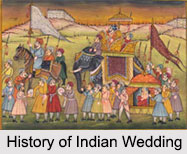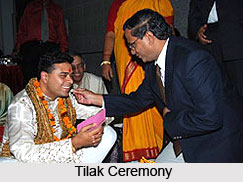Introduction
Bengali Weddings, like most other Indian weddings are a blend of traditional customs and rituals. These weddings are full of colour and vivacity. Bengalis believe that a marriage signifies the beginning of a new journey not just for the couple but for the entire clan.
Bengali Wedding Rituals
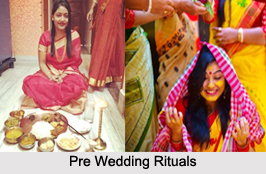 Rituals in Bengali Wedding are quite long and elaborate. There are a number of rituals and ceremonies that take place during the wedding. The blowing of the conch shell and ululation by the women gathered at the wedding venue are most characteristic of a Bengali marriage. Shehnai recital played by live musicians or else played over a music system adds to this symphony. The pre-wedding and post-wedding rituals provide ample opportunity to the loved ones to enjoy with each other. However, the traditional Bengali rituals are quite meaningful and interesting.
Rituals in Bengali Wedding are quite long and elaborate. There are a number of rituals and ceremonies that take place during the wedding. The blowing of the conch shell and ululation by the women gathered at the wedding venue are most characteristic of a Bengali marriage. Shehnai recital played by live musicians or else played over a music system adds to this symphony. The pre-wedding and post-wedding rituals provide ample opportunity to the loved ones to enjoy with each other. However, the traditional Bengali rituals are quite meaningful and interesting.
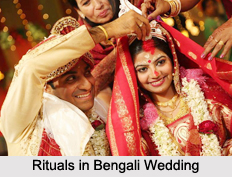 The wedding day rituals begin with welcoming the "Bor Jatri" i.e., the groom and the members of the groom"s house as well as his friends. An elderly female relative welcomes the groom with "Baran Dala". It is a plate which is first touched to the forehead of the groom, then touched to the ground and then again touched to his forehead. After this, the groom is given sweets and sherbet. As he enters the house, rose water is sprinkled over him. The next is the "Shubho Drishti" ritual, wherein the bride and the groom see each other for the first time.
The wedding day rituals begin with welcoming the "Bor Jatri" i.e., the groom and the members of the groom"s house as well as his friends. An elderly female relative welcomes the groom with "Baran Dala". It is a plate which is first touched to the forehead of the groom, then touched to the ground and then again touched to his forehead. After this, the groom is given sweets and sherbet. As he enters the house, rose water is sprinkled over him. The next is the "Shubho Drishti" ritual, wherein the bride and the groom see each other for the first time.
This is followed by "Mala Badal" ceremony, wherein they exchange garlands. The most important rituals on the wedding day are "Saat Paak", during which the bride is seated on a wooden plank and lifted by her brothers. Thereafter she is taken around the groom 7 times, which signifies their union. In "Sampradan" ritual the paternal and maternal uncles of the bride, give her away to the groom. After this, the "Yajna" ritual takes place where the bride and groom sit in front of the sacred fire and chant mantras after the priest. Agni, the fire god is made the divine witness to the marriage. Lastly the "Sindoor Daan" is done where the groom applies Sindoor or vermilion (a symbol of marriage worn by Hindu women thereafter) on the bride"s hair-parting. The bride then covers her head with a new saree offered by the groom.
Bengali Pre-Wedding Rituals
The pre-wedding rituals of the Bengali wedding marks the beginning of the grand wedding ceremony. Starting with "Aashirwad", this ritual is the conformation of marriage alliance that is performed few days prior to the wedding. An "alpana" along with a small banana tree is placed at the entrance of the house. Under the tree a copper vessel called "mangol ghot" is placed. A "Vridhi Puja" is conducted for offering worship to the ancestors of Bride and Groom. Then the bride`s family gives a grand rich supper known as "Ai Buro Bhaat", the night before the wedding. 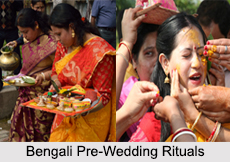
"Dhodhi Mangal" is a ceremony performed at both bride and groom`s houses at the dawn in a nearby pond. They invite the Goddess Ganga for the wedding. Then comes the "Gaye Holud" ceremony in which a paste of turmeric is applied to her body.
Bengali Post-Wedding Rituals
After the wedding the "Basar Ghar" ceremony takes place, wherein the newly wed couple is treated warmly and served delicious food. On the next morning the "Bashi Biye" ritual takes place in which the groom again applies vermilion on the bride"s forehead. After this, the "Bidaai" ceremony is held and the bride leaves with the groom for her marital abode. The first ceremony at groom"s place is "Bou Baran", which is a welcome ceremony for the bride. The bride submerges her feet in a plate containing lac dye and milk and enters the house, leaving imprints. Then come "Kaal Ratri" where the newly wed couples are separated for the night, probably to get a refreshing sleep and prepare for the next day"s final wedding ceremony. The next is the "Bou Bhaat" ceremony. It is held as the bride eats her first meal in her husband"s house. The wedding ceremony ends with "Phool Shojya" where the couple is adorned with flowers and are left together alone in their room to enjoy conjugal bliss on a bed laid with flowers.
Costumes in Bengali Wedding
The bride adorns herself in all her bridal finery. Her hair is tied into a bun and covered with a veil. A mukut is placed on her head. After her bridal makeover, a design of the mukut is traced on her face using the chandan paste.
The bridegrooms in Bengali wedding wear a silk Dhoti and Kurta, along with topor, which is a paper and shoal conical hat. However, while performing the marriage rituals the groom drapes a silk cloth around his body known as the "jor". The end of this cloth is tied to the anchal of the bride"s saree.
Symbolism of Food in Bengali Wedding
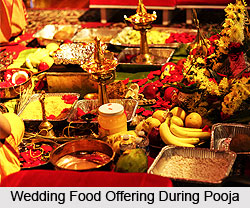 Weddings among Bengali Hindus are elaborate affairs, stretching over three days, with the preparatory rituals beginning even a week in advance. The three-day wedding ceremony is frequently punctuated by the symbolism of food, whether it is something she eats, serves or offers to the gods. Starting from the early morning hours of the nuptial day and subsequently, at different points in her life, the Bengali bride undergoes a series of important transitions- as wife, mother, widow- that are underlined by special meals (or the lack thereof). The meals constitute social and religious affirmation of each of these stages. As much as rituals and mantras, food- offered, consumed or abstained from- defines the rites of passage in a Bengali woman`s married life.
Weddings among Bengali Hindus are elaborate affairs, stretching over three days, with the preparatory rituals beginning even a week in advance. The three-day wedding ceremony is frequently punctuated by the symbolism of food, whether it is something she eats, serves or offers to the gods. Starting from the early morning hours of the nuptial day and subsequently, at different points in her life, the Bengali bride undergoes a series of important transitions- as wife, mother, widow- that are underlined by special meals (or the lack thereof). The meals constitute social and religious affirmation of each of these stages. As much as rituals and mantras, food- offered, consumed or abstained from- defines the rites of passage in a Bengali woman`s married life.
The first day, in particular, is an endurance test of fasting amid feasting. Long before sunrise on her wedding day, the young woman leaves her bed. Soon it is time for her to begin her own rituals of the day- be anointed with an oil and turmeric paste, bathe, change into fresh clothes and pray to gods and ancestors for a long and happy married life. In rural homes, especially in the old days, the women of the family would go to the nearest pond or lake or river to issue a symbolic invitation to Ganga, the eponymous goddess of India`s holiest river, and bring in a pitcher of water that would be sprinkled on the bride, and later, on the groom when he came for the wedding. After her bath, the bride is ushered by the female relatives to the space that has been cleaned and made ready for the first of several significant meals that will mark the different stages of the three-day wedding ceremony. It is not a rich, elaborate, multi-course repast, the kind that will be served to wedding guests at the banquet later in the day. Instead, in most families, it is a simple breakfast, consisting of yoghurt, fruits and rice flakes, with perhaps the addition of a few sweets. But it is loaded with symbolism, as even the name dadhimangal (unchanged from the original Sanskrit language) implies, dadhi meaning yoghurt and mangal meaning auspiciousness. As she eats, with her aunts, sisters and cousins blowing conch shells and ululating (both sounds intended to frighten away evil influences), the bride knows that this meal will have to sustain her through the long day until the evening`s wedding ceremony is over; her relatives have already advised her to eat heartily. In the eyes of an observer, however, this ritual meal extends beyond the literal nourishment of food. It stands as the first milepost in the transformative journey the woman has now undertaken.
The same food stuffs are also offered to the deities, and by consuming them at a sanctioned hour, with the accompanying prayers and rituals performed by her relatives, an ordinary human being is lifted out of her daily life and may come close to the plane inhabited by a deity. On this most significant day of her life, the woman thus verges on becoming a goddess.
Daylong fasts are hard enough for a healthy young person with natural appetites; for the Bengali bride, as the hours go by, the ordeal is intensified by the varied activities focused on food and cookery that fill the home. Late in the morning, the groom`s family sends a whole array of gifts -the tatwa- which includes clothing, jewellery and decorative objects, but whose centerpiece happens to be an imposing carp, its head patterned with turmeric and vermilion paste, its girth encircled by a jasmine garland. The fish is a symbol of plenty, prosperity and fertility; but beyond the symbol, it is intended to be cooked and eaten for lunch by the bride`s family. Aside from the carp, the tatwa also includes lavish supplies of sweets which assembled relatives and guests freely sample; it is one of the pleasures of a wedding in the family. Meanwhile, as morning deepens into afternoon and the kitchen emits many enticing aromas, the bride remains enclosed in her capsule of abstinence.
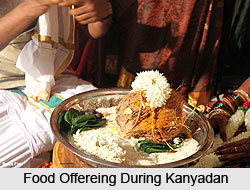 In the evening, once the wedding ceremony is under way, food assumes a different kind of significance. Instead of being a delectable concoction that tempts the human palate or nourishes the human body, it becomes a sanctified offering intended for Lord Agni, the god of fire, who is the witness to the union of man and woman. One way of describing the married state in colloquial Bengali is sat pakej bandha, referring to the seven cir-cumambulations the couple has to perform around the ritual fire that the priests have lit for them. Before that, however, bride and groom have to stand together, she in front, he behind, their hands jointly holding plates containing popped rice, fruits and sweets, all of which they pour into the fire in approved sequence. Each time food meets fire, the flames rise up in response. Participants and observers take it as a blessed sign that Agni has accepted the offering and ratified the union.
In the evening, once the wedding ceremony is under way, food assumes a different kind of significance. Instead of being a delectable concoction that tempts the human palate or nourishes the human body, it becomes a sanctified offering intended for Lord Agni, the god of fire, who is the witness to the union of man and woman. One way of describing the married state in colloquial Bengali is sat pakej bandha, referring to the seven cir-cumambulations the couple has to perform around the ritual fire that the priests have lit for them. Before that, however, bride and groom have to stand together, she in front, he behind, their hands jointly holding plates containing popped rice, fruits and sweets, all of which they pour into the fire in approved sequence. Each time food meets fire, the flames rise up in response. Participants and observers take it as a blessed sign that Agni has accepted the offering and ratified the union.
There are more rituals to follow and the Bengali bride has to wait until these have been completed before she can taste the first morsels of food. Along with the groom, she is then subjected to many playful folk customs. One of these entails the young couple feeding each other with sweets from a common plate, which necessarily includes intimate touching between hand and mouth.
The ritual of baran, or welcome, is performed both when the groom arrives at the bride`s house and when he returns home with her after the marriage. It is strictly a women`s ritual. A large brass platter, containing flowers, leaves, the obligatory dhan and durba and sometimes even small oil lamps, is held by the mother or other senior female relative and waved in circular motions in front of the groom or the married couple, to the accompaniment of ululation and the blowing of conch shells by other women. When major deities are worshipped on their annual festive days, priests welcome them with a similar ritual. Before they finally enter the house, the bridal pair is given something sweet to eat.
Bou Bhaat takes place on the third and final day of the wedding festivities. This is basically a custom where the bride has to cook the afternoon meal and serve it to her in laws. This traditional meal usually consists of rice, vegetables, dal and fish. This meal marks her role as a mature, nurturing woman who can take care of her family`s needs. Only after she has served her in-laws, can the bride sit down to eat.
As expected, the role of rice is also pivotal in the wedding rituals. Apart from the alpanas, which are joyously painted all over the house and on the pins (low rectangular wooden stools) where the bridal pair will sit, rice is also used to signify the auspiciousness of the ceremony. On the night before the wedding, women in the bride`s family build a small mound of rice powder (plain or dyed), called a Sree. This is supposed to be a symbol of Lakshmi (Sree or grace being another name for her) whose favour is essential to the success of the marriage.
Thus a Bengali marriage is replete with symbolism of food. Every act related to consumption of food or even fasting has some kind of religious and cultural significance behind it which is an essential part of a traditional Hindu Bengali wedding.
Bengali Wedding Tatwa
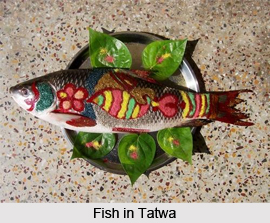 Customarily, both the bride and groom`s family exchange gifts. On the marriage day, the groom`s family sends gifts to bride as blessings called "Gatraharidra Tatwa" (which includes Sarees, cosmetics and accessories along with a fish and sweets). However, on the third day of marriage bride`s family send gifts to the groom`s family as blessings to the newly married couple. The idea behind this "Fulosajja tatwa" is to contribute something to the newly married ones to start their journey together.
Customarily, both the bride and groom`s family exchange gifts. On the marriage day, the groom`s family sends gifts to bride as blessings called "Gatraharidra Tatwa" (which includes Sarees, cosmetics and accessories along with a fish and sweets). However, on the third day of marriage bride`s family send gifts to the groom`s family as blessings to the newly married couple. The idea behind this "Fulosajja tatwa" is to contribute something to the newly married ones to start their journey together.
Importance of Tatwa
Weddings among Bengali Hindus are elaborate affairs, stretching over three days, with the preparatory rituals beginning even a week in advance. There are a number of ceremonies and rituals that take place all throughout the wedding, some before the Big Day and some after. Among the various pre-marriage ceremonies, the Hindus of West Bengal have the custom of sending a tatwa or ceremonial gift presentation from the bride`s family to the groom. 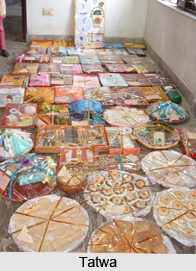 Although the array of gifts can vary, including clothes, furniture, jewellery or sweets, the centerpiece is always a carp, decorated elaborately with oil and vermilion. The largest fish that the family can afford is acquired for this purpose and the visual totality of the apparition is stunning: gleaming, pinkish-silver scales, the dark fins and tail, the lovingly painted vermilion patterns and the background of green (the banana leaf on which the fish rests).
Although the array of gifts can vary, including clothes, furniture, jewellery or sweets, the centerpiece is always a carp, decorated elaborately with oil and vermilion. The largest fish that the family can afford is acquired for this purpose and the visual totality of the apparition is stunning: gleaming, pinkish-silver scales, the dark fins and tail, the lovingly painted vermilion patterns and the background of green (the banana leaf on which the fish rests).
Tatwa Suchi in Tatwa
The Tatwa Suchi is an index of the items which is given in the tatwa. Different kinds of "sandesh", "Rosogulla", dry fruits and fruits are also included inside a tatta. The ideal tattwa includes a saree for the groom`s mother, and fish, sweets, curd, "paan", "dhaan", and "durba". The gifts are carried on a brass plate or a "kasar thala" and borne by the servants from the home of the bride. 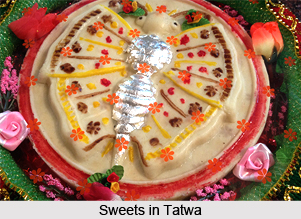 The fish is a symbol of plenty, prosperity and fertility; but beyond the symbol, it is intended to be cooked and eaten for lunch by the bride`s family. Aside from the carp, the tatwa also includes lavish supplies of sweets which assembled relatives and guests freely sample; it is one of the pleasures of a wedding in the family. Sometimes a fish is also decorated as a bride with actual "nath" and red and gold "chunni".
The fish is a symbol of plenty, prosperity and fertility; but beyond the symbol, it is intended to be cooked and eaten for lunch by the bride`s family. Aside from the carp, the tatwa also includes lavish supplies of sweets which assembled relatives and guests freely sample; it is one of the pleasures of a wedding in the family. Sometimes a fish is also decorated as a bride with actual "nath" and red and gold "chunni".
The funny way by which the clothes are carved into interesting shapes is also an interesting part of the tatwa. Other gifts include clothes, accessories and cosmetics for bride / groom and his/her immediate relatives.


















